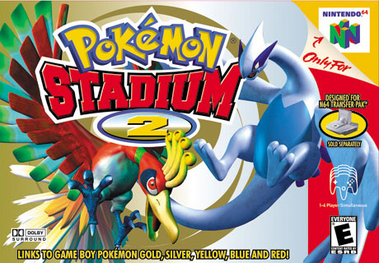Developer: Nintendo EAD, HAL Laboratory Publisher: Nintendo
Released: March 28, 2001 Rated: E 9/10
Whatever expectations may have been tempered in looking back on Pokémon Stadium as a standalone title, it’s a pleasure to say that Pokémon Stadium 2 does more than just add Generation II to the formula. The Swiss Army knife of features and tools like a Pokémon organization system, a Pokédex featuring the game’s 3D models, and, of course, the GB Tower for playing your GameBoy cartridge on the big screen all return in this package, but Stadium 2 takes a major step forward in making a game that can suffice even without the accompanying handheld titles.
The bulk of your visit to White City — Pokémon’s own version of Minas Tirith, apparently — will likely still focus on most of the same locations as in the first game, largely based around different ways to conduct battles. A free battle arena for any impromptu battle with friends not rolling up with their own transfer paks and copies of Blue, Yellow, or Silver; a Gym Leader Challenge to test your team-building skills as well as your endurance; the central Stadium to compete in various cups and tournaments with varying rule sets and restrictions. There are other ways to spend time, of course, but having plenty of options to launch into a Pokémon battle is still the backbone of the Stadium experience.

Of course, as we saw in the first entry, battling can often feel incomplete if you don’t have a GameBoy cartridge and Transfer Pak to use your own team, as “rental” pokemon with pre-set move sets and stats are generally so much less effective. Stadium 2 improves this experience with one excellent new option: Challenge Cup rules. This gameplay style essentially gives players a semi-randomized team to take into battle against other random teams. Doing this as a single player cup results in something of a precursor to the Battle Tower in Ruby/Sapphire or Battle Frontier in other later generations, as you don’t get to pre-plan and are strictly being tested on your battling strategy. Between how well this format works without any additional prep and the fact that it can be done ad nauseum and without repetition massively bolsters the appeal of Pokémon Stadium 2.


This goes double for battles between human players, who will always have a fair fight to enjoy, especially when they’ll each be able to roll into the battle without knowing which three of the six Pokémon made available each has chosen. The selected Pokémon even differ from both the standard rental options and from other generated Challenge Cup Pokémon — even if both players are given, say, a Gengar, and both choose it as one of their three battlers, each one will have different stats and moves, rather than a pure mirror match. This option alone makes Pokémon Stadium 2 one of the games on the N64 that offers the most lasting appeal, as you’ll always have the option of popping this one in to keep your battling skills sharp or test them against your friends without any fluff or setup around it.

The other major game mode, once again, is the mini game selection, no longer referred to as “Kids’ Club” so as not to imply it’s off limits to the big boys who just wanna cut some logs or play Beyblades. In my opinion, the selection in Stadium 2 far surpasses that of the first, even if none of the dozen new games on hand are truly as good as “Sushi-Go-Round.” Controls definitely make up a lot of that preference, as I think they’re both easier to pick up as well as just being a little bit better in concept. They’re usually quite simple but have a solid extra mechanic, like lifting the four-player Pong clone from Crash Bash and adding a force-push move that adds some spin as well. A good tournament format and a Pokémon quiz round out the game modes for a really solid package with a good amount of things to do outside of the robust battling system.

Between really entertaining and diverse ways to battle, some really good resources and training materials to brush up on your knowledge, and a lot of distractions and bells and whistles to entertain yourself with in between, Pokemon Stadium 2 elevates the experience of the first game to something you can really enjoy alone or with friends without depending on the main series games to prove worthwhile. Though it’s always going to have something of a ceiling without a full adventure or campaign like the GameBoy games, Pokemon Stadium 2 is as good as any console title the series could offer in the days before the Switch combined the handheld and console lineages.
Additional Information
Saves: Cartridge
Players: 4
Compatible with: Transfer Pak, Expansion Pak
Print Guides: BradyGames, Prima, Nintendo Power, Versus Books
Aggregate Critical Reception (GameRankings): 73.31%, based on 18 reviews
Other releases: JP, December 14, 2000, as Pocket Monsters Stadium Gold and Silver
AU, April 7, 2001
EU, October 10, 2001
My Streams
Commercials and Print Ads




